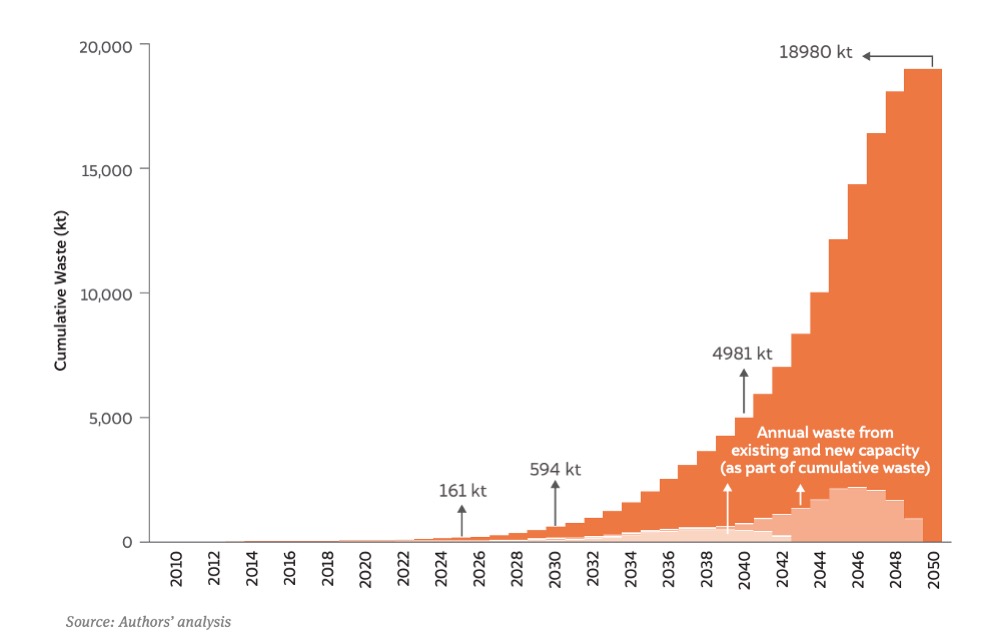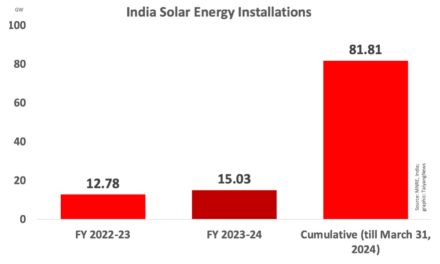- CEEW estimates India’s solar PV waste to grow to about 600 kt by 2030, and thereon by 32 times till 2050
- Rajasthan, Gujarat, Karnataka, Tamil Nadu and Andhra Pradesh will generate the largest volumes of this waste
- India should see it as an opportunity to establish itself as a leading hub of circular economy
- The solar industry, academia and the government need to work together to prepare for this scenario
In 2030, by when India targets to achieve around 292 GW of cumulative solar PV capacity, the country will also be looking at some 600 kilotonnes (kt) of solar waste, equivalent to filling up 720 Olympic-size swimming pools. This could grow 32 times to up to 19,000 kt by 2050, according to a new study by the Council on Energy, Environment and Water (CEEW).
As of FY 2023, its solar PV capacity was 66.7 GW, which has generated about 100 kt of cumulative waste. As new capacity comes online and retires, this waste will increase to 340 kt by 2030, according to the report titled Enabling a Circular Economy in India’s Solar Industry Assessing the Solar Waste Quantum.
This translates into 56% share of cumulative waste generated due to existing capacity by 2030, increasing to 74% by 2040 as existing installations reach end-of-life. By 2050, 77% of the cumulative waste generated will be due to new capacities.
Close to 67% of this solar waste will come from the 5 leading solar states of Rajasthan, Gujarat, Karnataka, Tamil Nadu and Andhra Pradesh. Rajasthan will account for 24% of the waste generated by 2030, followed by Gujarat’s 16% and Karnataka’s 12% share.
Opportunity
It does not only comprise modules that reach end-of-life, but also those that get damaged during transportation or faulty module handling and project operations.
Authors of the report see this as an opportunity for India to emerge as a leading hub of circular economy for the solar industry and ensure resilient solar supply chains.
Recycling of these modules will help extract valuable minerals that can go back into the supply chain, thus reducing production costs.
According to the CEEW estimates, the 334 kt waste generated from the existing capacity (with 93% crystalline silicon-based module technology) by 2030 translates to about 5.1 GW in solar capacity (using the 65 tonnes/MW conversion factor). It will likely comprise a total of 252 kt of glass, 32 kt of aluminium, 10.4 kt of silicon, and 12–18 tonnes of silver. It will also contain 16 tonnes of cadmium and tellurium each, and 190 tonnes of lead.
Recommendations
The Indian solar industry can prepare for this scenario by arranging reverse logistics, storage, dismantling centers, and recycling facilities. These will also lead to job creation.
Authors also recommend exploring innovative financing mechanisms and business models for solar waste management. The industry can work with the academia to accelerate module recycling technology innovation.
On the government’s part, the Ministry of New and Renewable Energy (MNRE) can maintain a comprehensive database of the installed solar capacity to provide accurate and granular mapping, across various deployment modes.
The Ministry of Environment Forest and Climate Change (MoEFCC) has included solar cells and modules in the Electronic Waste (Management) Rules. However, the authors want the ministry to issue guidelines for collecting and storing solar waste, while promoting safe and efficient processing of the stored waste.
“India must proactively address solar waste, not just as an environmental imperative but as a strategic necessity for ensuring energy security and building a circular economy,” said CEEW CEO Dr. Arunabha Ghosh. He added that robust recycling mechanisms are not only crucial, but also safeguard renewable ecosystems, create green jobs, enhance mineral security, foster innovation, and build resilient, circular supply chains.
The complete report is available for free download on CEEW’s website.















